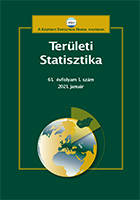A munkanélküliség és a közfoglalkoztatás területi
különbségei, összefüggései Magyarországon
Territorial differences and correlations of unemployment and workfare employment in Hungary
Author(s): Tibor KótiSubject(s): Social Sciences, Economy, Geography, Regional studies
Published by: Központi Statisztikai Hivatal
Keywords: unemployment; labour market; workfare employment; education; territorial differentiation
Summary/Abstract: The present study analyses the territorial differences and correlations of unemployment and workfare employment processes that determine the primary and secondary labour market vulnerabilities the most, focusing on disadvantages arising from territorial differences. Using available data, it presents unemployment trends since the turn of the millennium and the impact of workfare employment in the period between 2014 and 2018, highlighting the differentiation resulting from changes over time. Settlement structure patterns that significantly affect unemployment receive special attention from the author. Labour market vulnerability can be well presented with size of settlement and its distance from the central areas. It can be stated that the smaller a settlement or farther from the centre, the higher the unemployment rate. A growing demand for labour raises the question of meeting employer needs, justifying the relevance of the present study. Workfare employment is a potentially labour-emitting tool, a tool that helps the primary labour market integration in a transitive way, therefore the author examines the employment impact of workfare employment from a territorial point of view. The study also analyses the relationship between unemployment and educational attainment in relation to exclusion from the labour market and participation in public work programs.
Journal: Területi Statisztika
- Issue Year: 60/2020
- Issue No: 05
- Page Range: 517-547
- Page Count: 32
- Language: Hungarian

